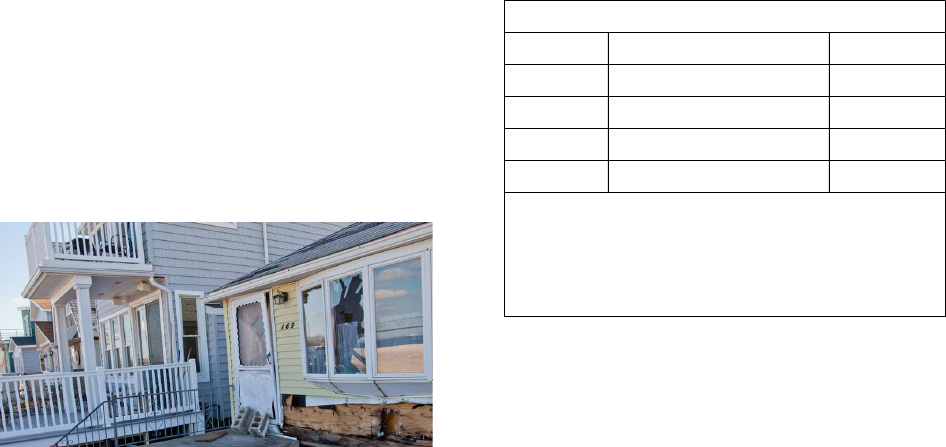
Costs of Freeboard
Under the rules of the National Flood
Insurance Program, buildings must be
protected to the base flood elevation.
Therefore, the cost of freeboard is just the
additional cost of building higher than the
minimum NFIP standard.
A 2006 study conducted for the American
Institutes for Research* looked at these
average additional costs for a 2,000 square
foot house. The findings are below, updated
to 2017 construction costs.
Foundation Type
Cost per
additional foot
Concrete block piers $890
Crawlspace with
concrete block walls
$1,850
Crawlspace with
poured concrete walls
$2,155
Stem wall with fill $2,345
Fill only $4,470
Using a house on fill with a stem wall (as
illustrated on the other side), here are the
average costs for various levels of freeboard:
1 foot: $2,345
2 feet: $2,345 x 2 = $4,690
3 feet: $2,345 x 3 = $7,035
* Evaluation of the National Flood Insurance Pro-
gram’s Building Standards, found at
www.fema.gov/media-library-data/20130726-1602-
20490-5110/nfip_eval_building_standards.pdf
Return on the Investment
The owner of a building built with freeboard
protection will realize the savings in two
ways. The most important way is when the
area floods again and the building is not
damaged and the owner does not have to
relocate, repair, and rebuild.
An immediate return will be in the form of
reduced flood insurance premiums. Every
building in the floodplain with a Federally
backed mortgage must have a flood insur-
ance policy to at least the amount of the
mortgage. The owner will pay the premi-
ums, either directly or through the lender’s
escrow account.
Here is an example using the 2,000 square
foot home with a stem wall foundation and
two feet of freeboard. Premiums are as
shown in the table on the other side.
Additional cost of construction: $4,690
Annual insurance premium
with no freeboard: $2,147
Annual insurance premium
with 2 feet of freeboard: $734
Annual premium savings: $1,413
Number of years to pay off
$4,690 via premium savings: 3.3 years
Added savings realized
during a 30 year mortgage: $37,300
The Benefits
and Costs
of Freeboard
Freeboard
BFE
Slab-on-Grade
Foundations
For more information: contact the ASFPM
Nonstructural/Floodproofing Committee at

Building in the Floodplain
All communities that participate in the
National Flood Insurance Program (NFIP)
must ensure that all new residential
buildings constructed in the floodplain be
elevated to or above the base flood elevation
(BFE). The base flood is the flood that has a
one percent chance of occurring or being
exceeded in any given year.
Many communities have concluded that the
base flood elevation is not a sufficient level
of protection. They have found:
Floods higher than the base flood can
and do occur.
Most flood studies do not account for
debris or obstructions during the base
flood, thereby underestimating the BFE.
NFIP flood studies do not account for
the impacts of future development or sea
level rise. Over time, the regulatory
standard does not keep up with increases
in flood elevations.
In non-coastal areas, the protection level
is measured at the top of the lowest
floor, leaving the flooring, subfloor, and
floor joists exposed to the base flood.
To help account for these shortcomings of
building only to the BFE, over half of the
communities in the country require free-
board, i.e., new buildings must be protected
to one or more feet higher than the base
flood elevation.
Benefits of Freeboard
A building built to a freeboard protection
level is better protected from:
Waves that are higher than the BFE,
Unpredictable flooding conditions, such
as debris at a bridge or culvert that
creates a dam to stream flow,
A base flood elevation that was under-
estimated by the typical study criteria,
Increases in flood heights due to devel-
opment and climate change, and
Damage to the floor joists and other
parts of the building lower than the top
of the lowest floor.
Through a national consensus process,
freeboard has been part of the International
Building and Residential Codes and the
American Society of Civil Engineers’
construction guidance (ASCE 24) since
1998.
One or two feet of additional elevation can
prevent thousands of dollars in flood damage.
Insurance Premiums with Freeboard
While the base flood elevation is the mini-
mum standard for communities in the
National Flood Insurance Program, the
NFIP encourages adoption of a freeboard
requirement (44 CFR 60.1(d)).
As seen in the table below, flood insurance
premiums are significantly lower for buil-
dings with 1, 2, or 3 feet of freeboard.
There is one simple reason for this: More
than forty years of insurance claims experi-
ence has proven that these buildings suffer
much less flood damage. Less potential for
damage means lower premiums.
Flood Insurance Premium Comparison
Zone Freeboard Premium
AE At BFE (no freeboard) $2,147
AE BFE + 1 foot $1,106
AE BFE + 2 feet $734
AE BFE + 3 feet $614
Premiums are for a single family house, one
floor, slab on grade or stem wall foundation,
$200,000 in building coverage, $80,000 in
contents coverage, $1,000 deductible, no CRS
discount, April 2017 Flood Insurance Manual
Lower insurance premiums are an immedi-
ate benefit of freeboard to the property
owner. Other benefits include less flood
damage in the community, less suffering
less business interruption, quicker recovery,
and higher property values.
